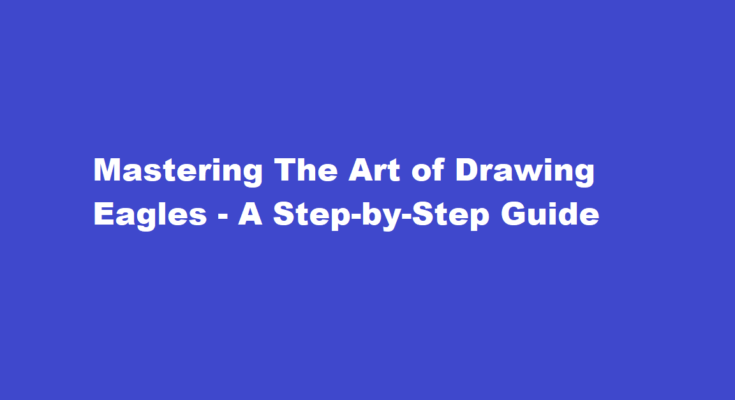Introduction
Eagles, with their majestic and powerful presence, have long been symbols of strength, freedom, and grace. Drawing these magnificent birds can be a rewarding and challenging artistic endeavor. Whether you’re a beginner or an experienced artist, this step-by-step guide will help you master the art of drawing eagles, capturing their beauty and essence in your artwork.
Materials You’ll Need
Before you begin your eagle drawing, gather your materials. You’ll need
1. Drawing paper: Choose a high-quality, acid-free paper that can withstand various drawing techniques.
2. Pencils: A range of graphite pencils, including 2H, HB, 2B, 4B, and 6B, for achieving different tones and shading.
3. Erasers: A kneaded eraser for fine details and a regular eraser for larger corrections.
4. Blending tools: Tortillons or blending stumps to smooth out shading.
5. Reference images: Find clear, detailed images of eagles for accurate representation.
Basic Sketch
Begin by lightly sketching the basic structure of the eagle. Start with a simple circle for the head and a rough oval for the body. Add a straight line for the beak and an upward-curving line for the back.
Define the Head and Beak
Refine the head by adding more details. Outline the beak more precisely and give the eagle a stern, determined expression. Pay close attention to the curve and proportions of the beak, as it’s a crucial feature of the eagle.
Outline the Body and Wings
Draw the body and wings. Eagles have strong, muscular bodies, so make sure to capture their bulk and proportions. Pay attention to the shape of the wings as they are essential for an eagle’s iconic look.
Add the Tail Feathers
Extend the sketch to include the eagle’s long tail feathers. These feathers play a vital role in their flight and should be well-defined.
Create the Eye and Facial Features
Focus on the eagle’s eye, one of the most captivating aspects of their appearance. Draw a circular eye with a prominent, intense gaze. Add detail to the facial features like the brow and the area around the eye.
Refine the Beak and Talons
Now, refine the beak and talons. Pay close attention to the shape, texture, and details of the beak, and make sure the talons are sharp and well-defined.
Feathers and Texture
Eagles have a magnificent array of feathers, each with its unique texture and pattern. Carefully draw the feathers on the body and wings, using the various pencils to create depth and texture. Start with the lighter pencils and gradually work your way to the darker ones for shading.
Shading and Highlights
To give your eagle drawing depth and dimension, focus on shading. Use the different pencils to create gradations from light to dark, emphasizing shadows and contours. Leave highlights on the beak, head, and body to make your eagle look more realistic.
Background
Consider the background of your eagle drawing. You can choose to leave it plain or create a natural habitat for your subject. A detailed background can enhance the overall composition of your artwork.
Final Details
Review your eagle drawing for any necessary adjustments or refinements. Pay close attention to the finer details, such as individual feathers and the texture of the bird’s plumage.
Tips for Success
1. Study Eagle Anatomy: Understanding an eagle’s anatomy is crucial for an accurate drawing. Study their skeletal structure, proportions, and plumage.
2. Use References: High-quality reference images are essential for capturing the intricate details of an eagle. Study photographs or watch videos to observe their movement and behavior.
3. Practice, Practice, Practice: Drawing eagles, like any art form, requires practice. Don’t be discouraged if your first attempts don’t meet your expectations. Keep practicing and refining your skills.
4. Experiment with Techniques: Try different techniques such as cross-hatching, stippling, and blending to achieve various textures and effects in your eagle drawing.
5. Patience is Key: Drawing eagles can be time-consuming, so take your time and be patient. Rushing can lead to mistakes and an unsatisfactory result.
6. Seek Feedback: Share your work with fellow artists or art communities to get constructive feedback. Learning from others can greatly enhance your skills.
FREQUENTLY ASKED QUESTIONS
What do eagles eat?
Bald eagles are opportunistic foragers but prefer fish as their primary food and are found in great densities where fish are abundant. They also eat sea birds and ducks or hunt over grasslands and marshes for small mammals such as rabbits, squirrels, prairie dogs and muskrats.
Is An eagle an animal?
The sharp-eyed eagle is among the most fearsome predators of the animal kingdom. Nicknamed the “king of all birds,” eagles are large and powerful birds of prey that appear to soar majestically in the air, searching for their next meal.
Conclusion
Drawing eagles is a challenging but immensely rewarding artistic endeavor. With patience, practice, and attention to detail, you can create stunning eagle drawings that capture the majesty and spirit of these magnificent birds. Remember to study their anatomy, use references, and experiment with various techniques to improve your skills and create art that truly soars.
Read Also : Crafting a Smoker – Minecraft’s Recipe for a Flavorful Gaming Experience



